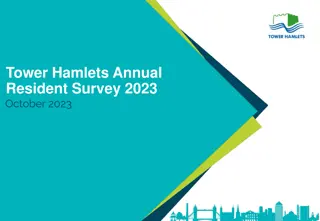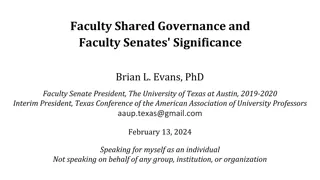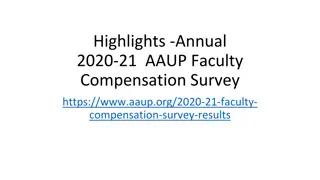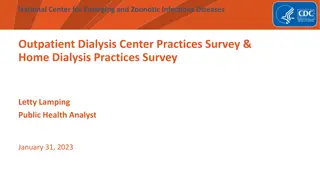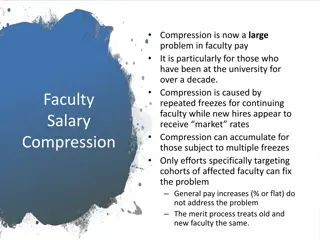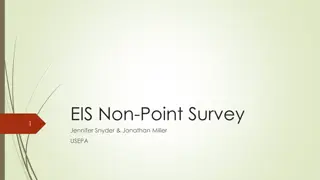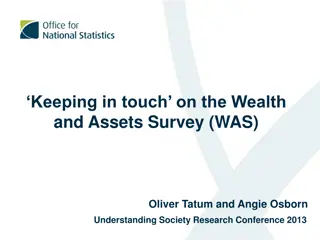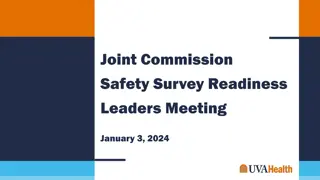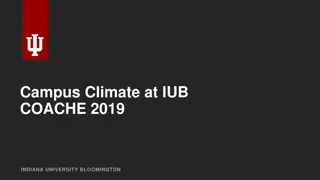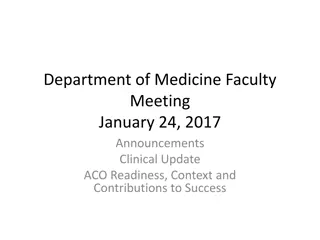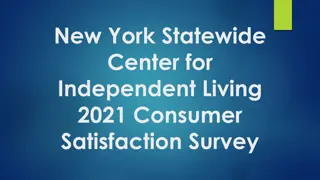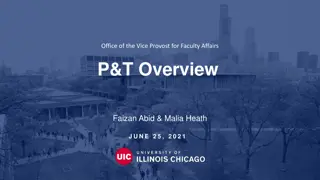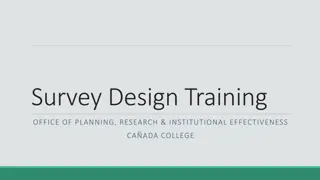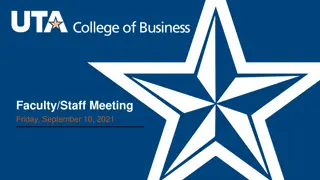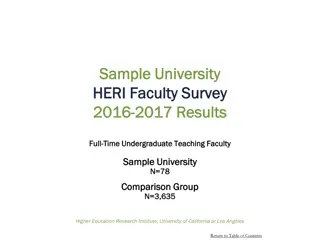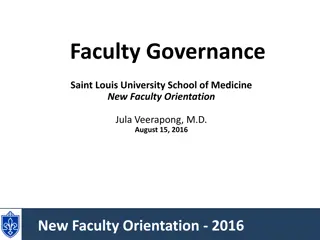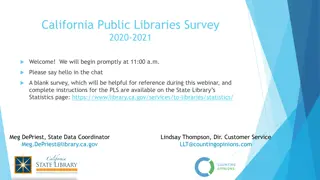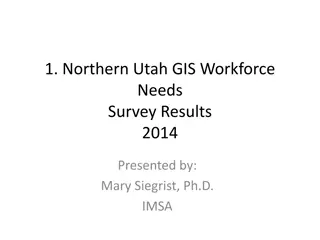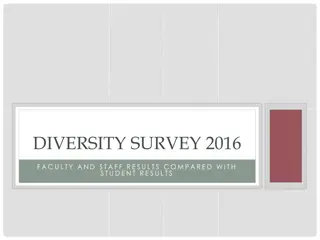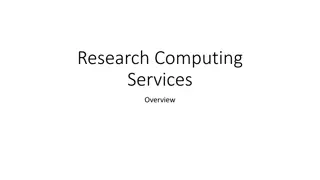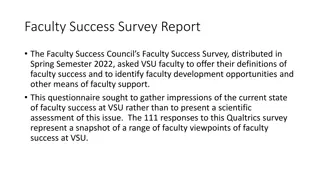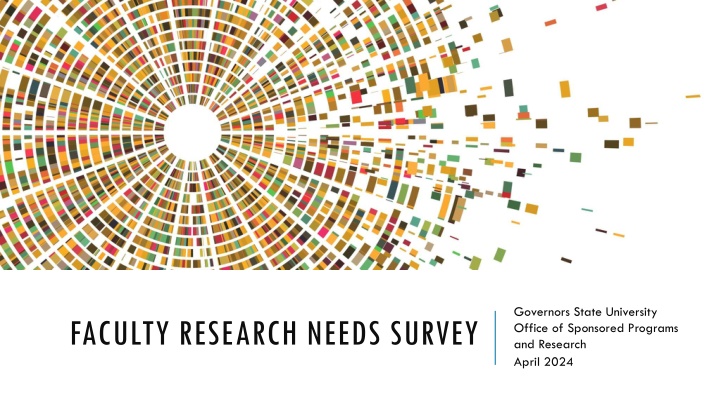
Survey Analysis: Faculty Research Needs at GovState University
Explore the results of a survey conducted by the Office of Sponsored Programs and Research at GovState University in April 2024 to assess faculty research needs. The survey aimed to enhance research support and guide future decisions on research endeavors. Faculty positions, workload distribution, time allocation, and research activities are analyzed to improve research support mechanisms.
Download Presentation

Please find below an Image/Link to download the presentation.
The content on the website is provided AS IS for your information and personal use only. It may not be sold, licensed, or shared on other websites without obtaining consent from the author. If you encounter any issues during the download, it is possible that the publisher has removed the file from their server.
You are allowed to download the files provided on this website for personal or commercial use, subject to the condition that they are used lawfully. All files are the property of their respective owners.
The content on the website is provided AS IS for your information and personal use only. It may not be sold, licensed, or shared on other websites without obtaining consent from the author.
E N D
Presentation Transcript
Governors State University Office of Sponsored Programs and Research April 2024 FACULTY RESEARCH NEEDS SURVEY
The survey was conducted in March 2024 by the Office of Sponsored Programs and Research at GovState University. The purpose of the survey was to identify areas where faculty research support may be improved and to inform the university's future decisions about supporting research endeavors. The survey was anonymous to encourage honest and unbiased responses. Respondents could skip the questions they did not want to answer. The survey was distributed via a faculty listserv to 274 faculty members On March 4, 2024. Three reminders were sent. The survey remained open for four weeks. 54 responses were received, yielding a response rate of 20%. METHOD AND PURPOSE
STRUCTURE OF THE SURVEY: 1. FACULTY POSITION AND WORKLOAD 2. RESEARCH TRAINING AND ACTIVITIES 3. RESEARCH, PROMOTION AND GOVSTATE S MISSION 4. SUPPORT FOR RESEARCH
FACULTY POSITION & WORKLOAD
CAS 28 (52%) CHHS 12 (22%) CEHD 9 (17%) COB, Library, Honors College, Graduate College, School of Extended Learning 5 (9 %) Assistant Professor 27 (50%) Associate Professor 16 (30%) Professor 8 (15%) Lecturer, instructor 3 (5%) RESPONDENT POSITION (N=54)
LAST SEMESTER Less than 9 credit hours - 6 (11.8%) 9-12 credit hours 30 (58.8%) More than 12 credit hours 16 (29.4%) THIS SEMESTER Less than 9 credit hours - 15 (29.4%) 9-12 credit hours 24 (47.1%) More than 12 credit hours 12 (23.5%) TEACHING WORKLOAD (N=51)
<20% 21%- 40% 41- 60% >60% N/A PERCEIVED TIME SPENT ON TEACHING AND OTHER DUTIES Teaching 3 9 14 26 1 Serving on university committees 16 22 8 3 3 Advising 25 15 5 3 4 (N=53) Administrative Duties 23 8 5 6 10 Conducting research 23 17 7 4 2 Writing grant proposals 22 3 1 1 24 Managing grants 18 2 1 1 28
RESEARCH TRAINING AND ACTIVITIES
31 (58.%) had extensive training in research methods during doctoral studies 28 (57.1%) would like to have additional training RESEARCH TRAINING (N=53)
Empirical social behavioral research 19 (34%) Theoretical social behavioral research 13 (24%) TYPES OF RESEARCH (N=53) Evaluation research 8 (15%) Community-based participatory research 8 (15%) Action research 7 (13%)
In the last three years, the number of research projects in which you have been involved as the PI/Co-PI: In the last three years, the number of research projects in which you have been involved as the faculty advisor: RESEARCH ACTIVITIES (N=54) Not involved 18 (33.3%) 1-2 projects 14 (25.9%) 3-5 projects 11 (20.4%) More than 5 11 (20.4%) Not involved - 7 (13%) 1-2 projects 23 (42.6%) 3-5 projects 19 (35.2%) More than 5 5 (9.3%)
RESEARCH, PROMOTION AND GOVSTATE S MISSION
Comments: If research and creative activity take on a higher priority in terms of faculty promotion, then there would need to be a decrease in the percentage of time expected for faculty to engage in teaching and administrative duties. SHOULD RESEARCH BE AN IMPORTANT CRITERION FOR PROMOTION AT GOVSTATE? (N=51) 23 respondents (45%) strongly agreed and agreed that research should be an important criterion for promoting faculty at GovState. 10 (19.6%) disagreed that research should be an important criterion for promoting faculty at GovState. Teaching quality and technique represent the most important criteria for being an effective professor. Research is embedded in teaching due to the emphasis on evidence- based practice. Service is also a requirement for professional practice so should also be considered a secondary criterion along with research.
Comments: Yes, it should be part - all institutions of higher ed should support research and faculty need to stay current in the field. 30 respondents (61%) strongly agreed and agreed that research should be a part of the university s mission. 5 respondents (10%) disagreed that research should be a part of the university s mission. SHOULD RESEARCH BE A PART OF GOVSTATE S MISSION? (N=49) Research should advance GSU's mission, not just be a part of the mission. It should be part of your identity as an academic. We should be able to justify and improve our craft with research, as well as pass these skills on to our students, both grad and undergrad. GSU should remain a teaching- focused institution that encourages and supports faculty research and creative activity for the purposes of making our teaching stronger.
4 respondents (8%) indicated that they are very satisfied and satisfied with the level of support for research at GovState. 32 (64%) indicated that they are very dissatisfied and dissatisfied. The respondents are most dissatisfied with: 1. Graduate assistants (41%) 2. Book buying funds (35%) 3. Internal grants & scholarships (30%) 4. Research software (30%) 5. Research facilities (27%) SATISFACTION WITH SUPPORT FOR RESEARCH AT GOVSTATE (N=53)
I believe that the administrative support for research is not aligned with faculty needs. We are unable to conduct our research because we are forced to jump through so many hoops at multiple levels. Time, technology, funding Limit of travel fund, no statistical support of research Service expectations and high teaching load No encourage and award policy for conducting research Insufficient staffing and training to get administrative tasks accomplished in a timely manner Time and start-up funds Moreover, many faculty are burned out from years of extreme teaching loads and lack of support. As a new faculty member, I have struggled to find resources and support to pursue an ambitious research agenda. Additionally, as I have tried to navigate those areas, I have been met with constant difficulty in being reimbursed for those efforts. MAIN BARRIERS TO RESEARCH This is a teaching school, not a research institute. Inconsistent with the institutional goals and research expectations.
Comments: Faculty development funds--to help faculty who conduct research as well as provide course release. Additional incentives need to be offered both to faculty and student RAs. Summer grants or stipends for faculty to do research so they don't have to take on extra work and can focus on research since the academic year is very busy with teaching and service. Invest money for up-to-date instruments 1. 2. Release time 47 (87%) Internal grants and scholarships 37 (68.5%) Travel funds 35 (64.8%) External grants and scholarships 22 (40.7%) Book buying funds 16 (29.6%) MOST NEEDED FINANCIAL RESOURCES (N=54) 3. 4. 5.
Comments: 1. Quantitative data analysis software available at no cost 33 (70.2%) 2. Survey software available at no cost 30 (63.8%) 3. Qualitative data analysis software available at no cost 26 (55.3%) 4. University-level data repository 24 (51.1%) 5. Department-level data repository 17 (36.2%) NVivo, Dedoose, R Inter-university Consortium for Political and Social Research (ICPSR) membership for access to data for secondary data analysis. Methods and tools for scoping reviews. Scoping reviews appear to be trending and are good efficient research studies that can be done with students and lead to publications and pilot projects including grants. MOST NEEDED TECHNICAL RESOURCES (N=47)
Comments: 1.Trained graduate research assistants 39 (75%) 2.Faculty development program 31 (59.6%) 3.Mentorship from senior faculty 31 (59.6%) 4.Data analysis and computing services 28 (53.8%) 5.Scientific writing and editing services 28 (53.8%) Graduate assistance/stipends. Students are actively advised to not attend schools that don't pay during a graduate program so we are viewed as a predatory institution within the sciences. With that policy, we will not be able to recruit students. Faculty writing retreats, workshops, bootcamps, etc. Plus dedicated time. We need a much more comprehensive writing center that also can help faculty with book proposals, article editing, etc. away from teaching. MOST NEEDED ACADEMIC RESOURCES (N= 52)
Comments: 1. Grant writing services 36 (75%) 2. Research proposal development services 30 (62.5%) 3. Research proposal budget preparation services 26 (54.2%) 4. Post-award, grant management training 22 (45.8%) 5. Pre-award training 19 (39.5%) Bring back the Undergraduate Research Grant; create a student research grant; create a faculty- student collaborative grant; provide funds for senior or accomplished faculty to mentor other faculty and give those faculty funds as well (faculty research mentorship program grant); have 1-2 larger, more competitive internal grants to create/sustain a research program that funds student research assistants. MOST NEEDED ADMINISTRATIVE RESOURCES (N= 48) Faculty Research Certification Program or Faculty Grant Writing Certification Program.
LIMITATIONS AND CONCLUSIONS
Non-representative sample o Small sample o For populations under 1,000, it is advisable to have a minimum ratio of 30 percent (300 individuals). For a population of 274, the ratio should be >50%. o Predominantly social behavioral researchers LIMITATIONS Self-selection bias (Bethlehem, 2010)
Growing GovStates research enterprise requires us to evaluate the resources available to our faculty. Some support we may consider: - Release time - Internal grant funding, stipends, and start-up funds - More graduate assistantships - Research software TAKEAWAYS - Secure space and maintenance for research equipment - Research mentors - Library resources - Statistical and editing services

